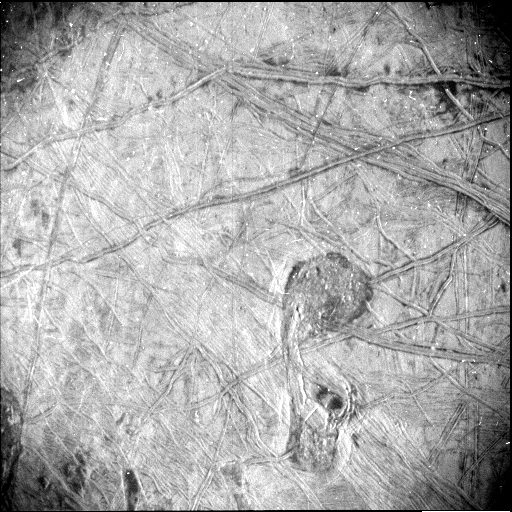Last week, NASA’s Juno completed its flyby of Europa providing the closest view of this celestial object in two decades. The second moon of Jupiter hides a deep ocean beneath its icy exterior and is one of the best candidates for life beyond our planet. Now NASA has released the highest resolution image of Europa yet, the complex surface of this frozen world clearly seen.
The image is 150 by 200 kilometers (93 by 125 miles), showing off the fine grooves and double ridges that are typical of this moon. There is a structure resembling a musical note. There are dark spots at the top of the image possibly related to eruptions from below the surface. What might be surprising, however, is the lack of craters. Celestial bodies often appear pitted by small and big impacts, but Europa’s surface changes show a young surface that formed between 20 and 180 million years ago.

The Full glorious image of Europa’s surface. Image Credit: NASA/JPL-Caltech/SwRI
A possibly surprising fact about this image is that it comes from the night side of Europa. Juno’s Stellar Reference Unit (SRU) – a star camera used to orient the spacecraft – can capture low-lighting photographs perfect for seeing the moon’s surface lit by the diffuse sunlight reflected by Jupiter.
The photo was snapped at 412 kilometers (256) of altitude, roughly the distance between the International Space Station and Earth’s surface, and has a resolution of 256 to 340 meters (840 to 1,115 feet) per pixel. The spacecraft was moving at 24 kilometers per second (15 miles per second) during the flyby, which is three times faster than the ISS.
“This image is unlocking an incredible level of detail in a region not previously imaged at such resolution and under such revealing illumination conditions,” Heidi Becker, the lead co-investigator for the SRU, said in a statement.
“The team’s use of a star-tracker camera for science is a great example of Juno’s groundbreaking capabilities. These features are so intriguing. Understanding how they formed – and how they connect to Europa’s history – informs us about internal and external processes shaping the icy crust.”
The team is now busy analyzing all the data collected by the various instruments during the flyby of Europa and the subsequent flyby of Jupiter 7.5 hours later. This was the spacecraft’s 45th orbit around the giant planet.
“Juno started out completely focused on Jupiter. The team is really excited that during our extended mission, we expanded our investigation to include three of the four Galilean satellites and Jupiter’s rings,” said Juno Principal Investigator Scott Bolton of the Southwest Research Institute.
“With this flyby of Europa, Juno has now seen close-ups of two of the most interesting moons of Jupiter, and their ice shell crusts look very different from each other. In 2023, Io, the most volcanic body in the Solar System, will join the club.”
Juno flew by Jupiter’s moon Ganymede – the Solar System’s largest moon – last year.
Source Link: Incredible Details Of Europa’s Icy Surface Revealed In Highest Resolution View Ever